Who needs a groundhog to tell us spring is here when we’ve got conifer tips?
If you live on the West Coast and have never noticed them before, we assure you that you won’t miss them again after reading this piece. Check out some spruces when the weather warms and you’ll see bright green tips — almost neon — wrapped in papery, sticky sheaths at the end of each branch.
These tips, also called buds, are many people’s gateway to foraging on the West Coast because of how easy they are to spot. You won’t be left out if you live in the city either, like Tyee reporter Chris Cheung. He spotted them growing alongside Vancouver’s BC Parkway right beside the SkyTrain, and in many of the region’s public parks and trails.
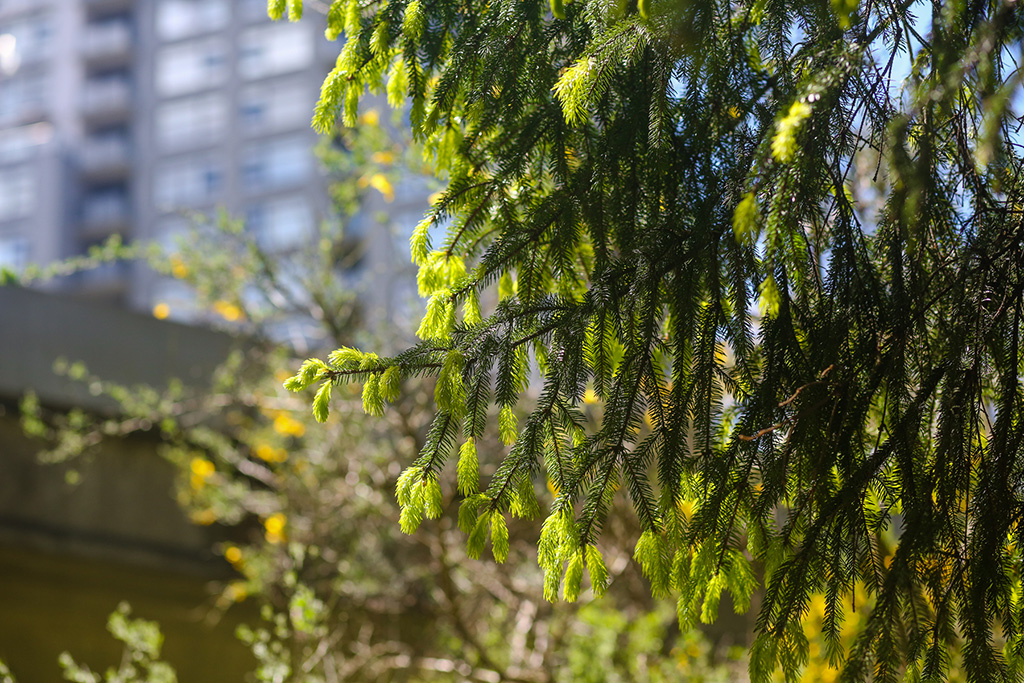
This year’s spring was so cold it broke records, but Chris in Vancouver was pleased to report that conifer trees started growing their tips about a month ago. Managing editor andrea bennett, however, anxiously waited for the spruce in their yard on the northern Sunshine Coast to do the same, only spotting them last week. As the old saying goes, a watched spruce never buds.
Spruce trees can look very similar to fir, its coniferous cousin. You can tell them apart by examining their needles. Pluck one and try to roll it between your fingers. Is the needle flat? Then it’s fir. Does it have four sides and roll easily? It’s spruce.
(If you’re still having trouble, here’s one of many videos out there that will help you find your spruce buddies. Read up, too, to avoid picking anything in the yew family — it’s poisonous!)
There’s a lot you can do with these tips. Crunch on them as they are. Make them into a salt, syrup or spice. Bumbling colonizers with deplorable histories like Captain Cook and Jacques Cartier would most likely have died of scurvy if they hadn’t been taught by Indigenous peoples to brew spruce beer — the tips are rich in vitamin C. Brewers, such as Tofino Brewing, still make use of tips today.
But as The Tyee’s resident ice cream aficionados, we’d like to suggest you turn them into an ice cream.
It might sound like some far-out, hippy-dippy self-parody of a West Coast flavour, but we promise spruce tip ice cream deserves a special place amongst the salted caramels and cookie doughs. And you don’t have to take our word for it — andrea consulted a professional while refining their recipe.
Kirsten Wood is an ice cream maker and owner of Blue Spruce Ice Cream, a small-batch shop located near the Fifth Street bridge in Courtenay. She is Cree from the Saddle Lake Cree First Nation in Alberta and grew up with her family on Vancouver Island.
For Wood, making spruce tip ice cream is in part an expression of the relationship between Indigenous approaches to food and locally available ingredients.
“Why not offer something from here?” she says. “Anyone can find blackberries or raspberries or mango. Spruce tips are a special thing we can do.”
Spruce tip ice cream was the first flavour Wood churned when she opened her shop four years ago, in mid-June 2018. She collects the tips while on long spring walks in the forest with Humble, a Catahoula leopard dog. Some tips she uses immediately, and others she freezes for later use. Fitting the name of her shop, Wood offers spruce tip ice cream throughout the year.
Wood’s technique involves making a traditional custard base, infusing some spruce tips while it’s hot, straining them out, and then adding another round of chopped spruce tips, along with some lemon juice, to the cooled base. She then infuses that mixture in the fridge for 36 hours before straining and churning it.
The plain custard base itself is quite flavourful, Wood says, and because we eat ice cream cold, we don’t have access to the aromas from the spruce tips we’d pick up on otherwise. So the trick with infusing these kinds of ice creams is to gently draw out the subtle flavours, she says.
Wood laughs when andrea asks her to describe what the resulting ice cream tastes like. “I always get asked this and I never know how to answer,” she says. “It doesn't taste like a pine tree at all. It almost is like melon or blueberry, with like a bit of citrus.”
If this piece has made you curious about what else you might gnaw on in your surroundings, we’d suggest learning more from foragers: Alexis Nikole, based in Columbus, Ohio, and on Instagram as @blackforager, shares great tips as well as recipes.
For her part, Kirsten Wood suggests experimenting with flavours from plants that emerge around the same time in the season. Elderflower, she says as an example, pairs very well with spruce tips.
On the other hand, if this piece has made your taste buds tingle but you’re not terribly interested in creeping into a local park with a pair of secateurs, no worries — spruce tip ice cream is available in late spring in shops across B.C., including Earnest Ice Cream in Vancouver, Wild Scoop in Powell River and, of course, Blue Spruce Ice Cream in Courtenay.
Give it a try if you’ve got a hankering for a scoop that couldn’t be more of this place.
How to make your own spruce tip ice cream
We’ve got two recipes here for you.
There’s andrea’s classic custard base that uses lemon and cold-infused spruce tips in larger pieces, rather than blending them in, based on Wood’s recommendations. andrea’s taste-testers likened their spruce tip ice cream to melons and peaches. Their partner, who isn’t known for being particularly effusive — or liking dessert — said it was “really good.”
Then there’s Chris’s Philadelphia-style base, if you want to leave out the yolks. It uses lime and blends in the tips, based on tips from the James Beard-nominated Forager Chef and the Salt & Straw ice cream company of Portland. Chris’s taste-testers likened the ice cream to melons, too, specifically the Melona-brand cantaloupe popsicle, but with woody notes.
First, you’ll need to gather about one cup of spruce tips, which emerge at different times depending on which part of B.C. you call home. These days, you’ll have better luck in Smithers, but might be able to still find some in the Lower Mainland.
There are 35 different types of spruce trees belonging to the genus Picea, and you can find many of them — including Sitka spruce, Norwegian spruce and blue spruce — in B.C.
Each species has its own distinct flavours, but they all generally start with a citrusy bite before it becomes resiny. New growth is edible right from the tree, so if there are several varieties of spruce in your surroundings, you can nibble on each before committing to gathering your tips. Though remember — don’t take too many from one branch or one tree.
andrea’s custard base with lemon
Time:
Two days total: Half an hour to cook the custard, 36 to 48 hours to steep, half an hour to churn.
Ingredients:
- 2 cups heavy cream
- 1 cup milk
- 2/3 cup sugar
- generous pinch of salt
- 6 egg yolks (save the whites for macarons or swiss meringue buttercream or amaretti — you can even freeze them for later use)
- 1/4 cup lemon juice
- 1 cup spruce tips
Tools:
- whisk
- medium-sized, heavy-bottomed pot
- medium-sized fine mesh strainer
- food thermometer (optional but helpful)
- ice cream maker (optional but helpful)
Directions:
- Place the six egg yolks into a mixing bowl. Whisk them together and set aside.
- Whisk the cream, milk, sugar and salt together in a medium-sized, heavy-bottomed pot on medium-low heat until the sugar has dissolved and the mixture is beginning to emit the tiniest bit of steam.
- Take the pot off the heat.
- Slowly drizzle about one-third of the hot cream mixture into the egg yolks, whisking constantly. The idea is to temper the yolks, which will keep them from scrambling.
- Once you’ve added one-third of the cream mixture into the yolks, it’s time to add that yolk mixture back into the main pot. Keeping the pot off the heat, slowly drizzle the yolk mixture back into the cream mixture, whisking constantly.
- Place the pot back onto a medium-low heat and gently cook the custard, whisking regularly.
- You’re looking for the custard to come to 170 F — or, if you don’t have a thermometer, until it’s thick enough to coat the back of a spoon.
- Remove the pot from the heat and let it come to room temperature for half an hour on the countertop.
- Meanwhile, wash and dry your spruce tips, and roughly chop them — leaving them in large-ish pieces is OK.
- After a half hour, stir 1/4 cup of lemon juice and your spruce tips into the custard base.
- Transfer into a bowl and place in the fridge (or just place the pot into the fridge, we’re not judging).
- Allow the spruce tips to infuse into the custard in the fridge for 36 to 48 hours.
- After 36 to 48 hours have elapsed, strain the custard through a fine mesh strainer into a new bowl. It’s okay if a few little spruce bits make it through.
- Churn the ice cream in your ice cream maker, or DIY it using a baking pan and a whisk.
- Serve in a cup or cone.
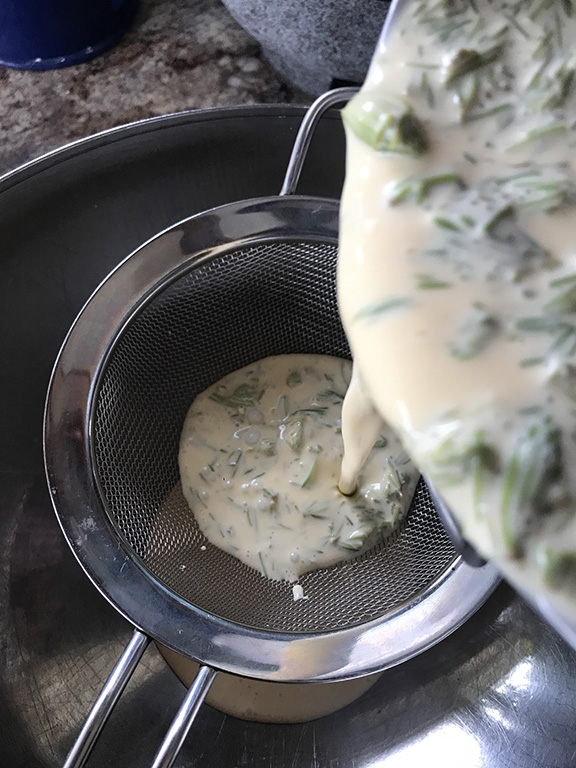
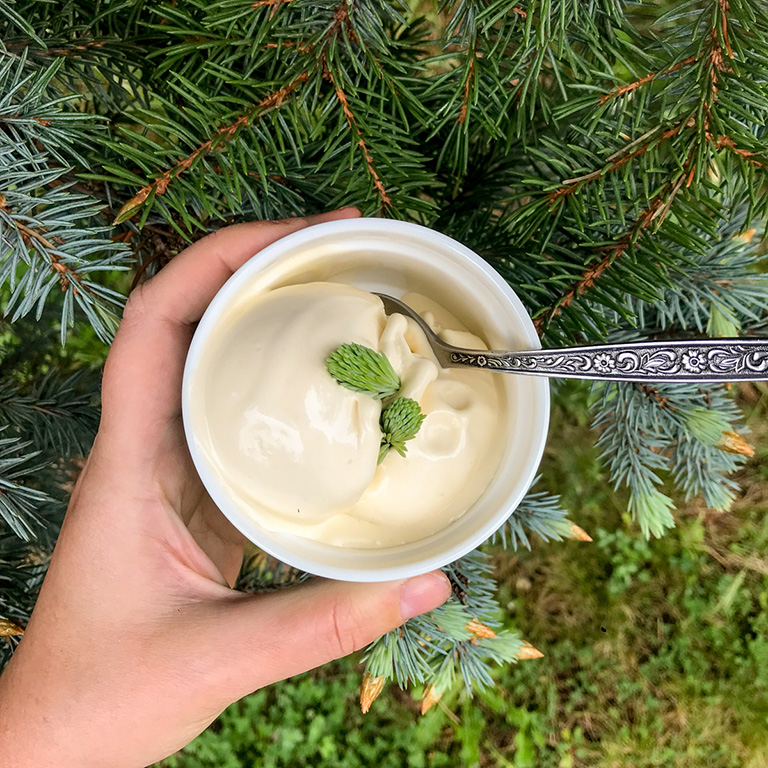
Chris’s Philly-style base with lime
Time:
Half an hour to prepare the base, another six hours to overnight to steep.
Ingredients:
- 1/2 cup sugar
- 2 tablespoons of milk powder (Chris uses Coffee-mate)
- Either 1/4 teaspoon of xantham gum or 1/8 teaspoon of guar gum
- 2 tablespoons light corn syrup
- 1 1/3 cups milk
- 1 1/3 cups cream
- 1/4 cup spruce tips
- 1 teaspoon of lime juice, or more.
Tools:
- whisk
- medium-sized pot
- medium-sized fine mesh strainer
- blender
- ice cream maker (optional, but helpful)
Directions:
- Whisk the sugar, milk powder and gum in a small bowl.
- Heat the milk in a pot at medium. Add the corn syrup and sugar mixture, whisking to prevent lumps.
- Continue whisking as the mixture heats up. Remove the pot from the heat when the ingredients dissolve, no need to wait for a boil.
- Add the cream and whisk until combined. There you have your base! Let it cool.
- Use a blender (a tool like a Magic Bullet will do) to break down the spruce tips completely. Add some of your base, a little bit at a time, if the spruce tips need some moisture to help them blend.
- Pass your blended spruce tips through a mesh strainer and into your base.
- Refrigerate the base for six hours or (if you’re patient) overnight.
- Add the lime juice (to your preference) then churn in your ice cream maker. Depending on your ice cream maker, you may need to store your finished product in the freezer for a few hours to firm up.
- Serve in a cup or a cone. Enjoy beneath some spruce trees.
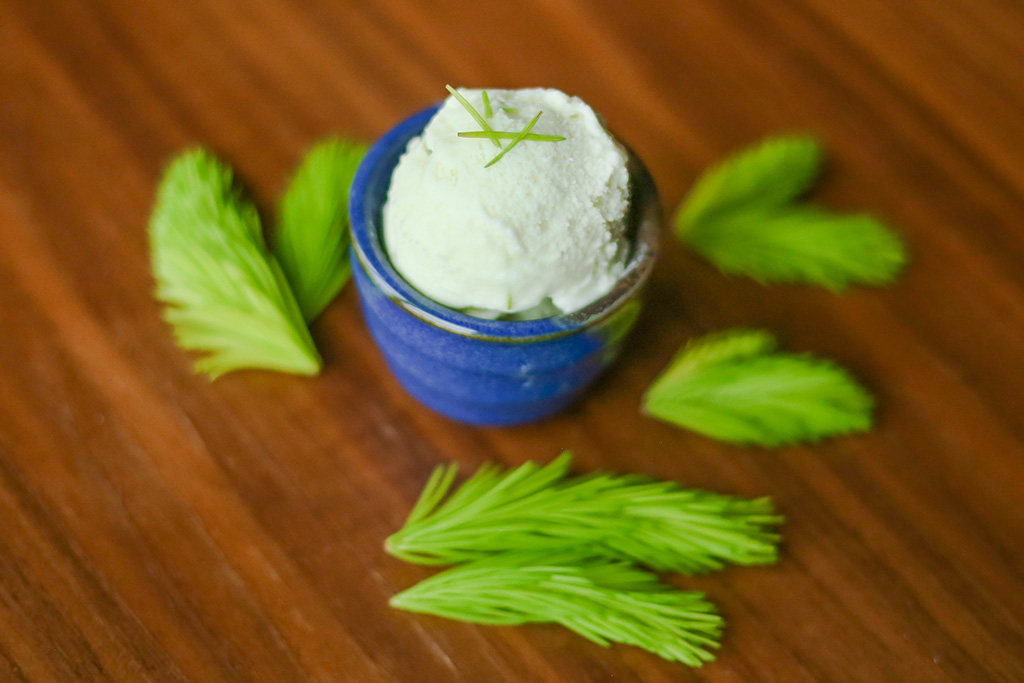
Read more: Food, Environment




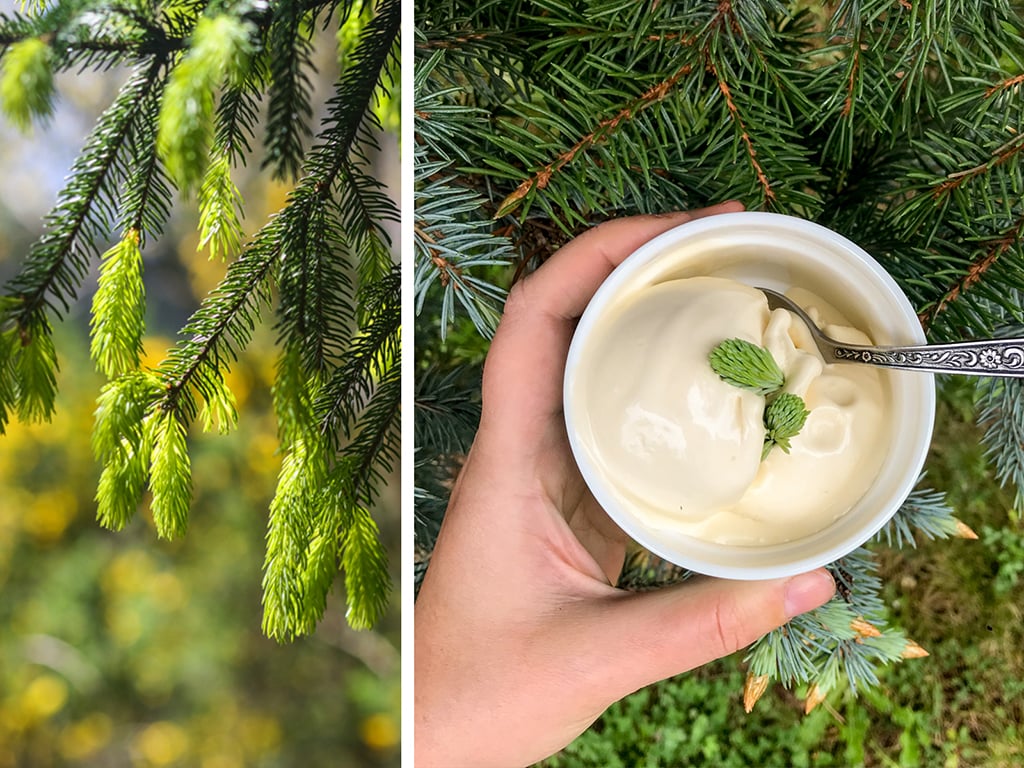












Tyee Commenting Guidelines
Comments that violate guidelines risk being deleted, and violations may result in a temporary or permanent user ban. Maintain the spirit of good conversation to stay in the discussion.
*Please note The Tyee is not a forum for spreading misinformation about COVID-19, denying its existence or minimizing its risk to public health.
Do:
Do not: